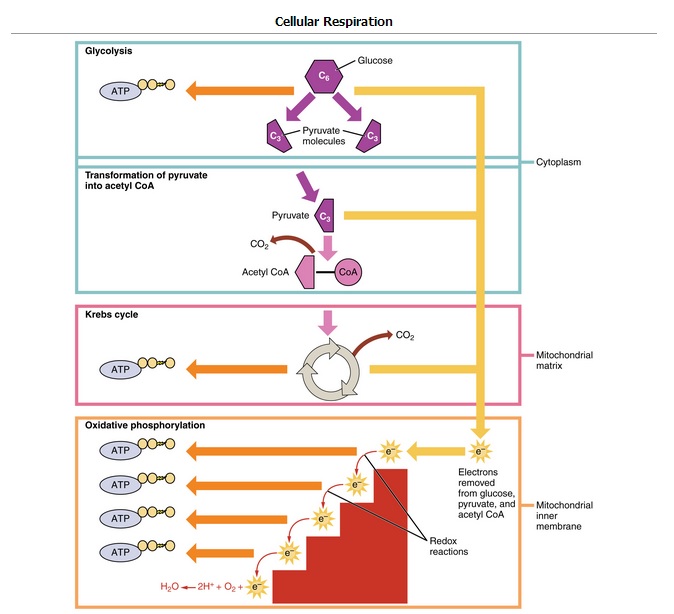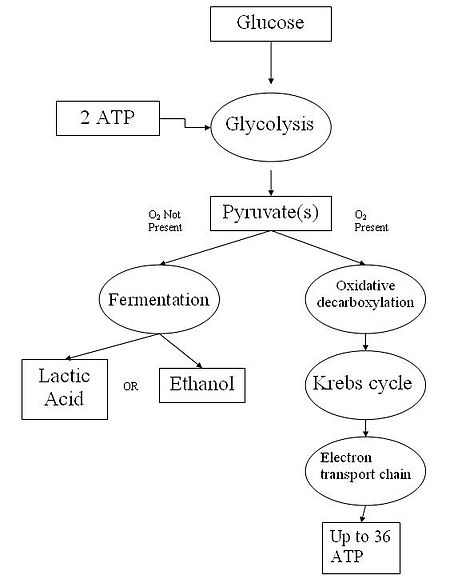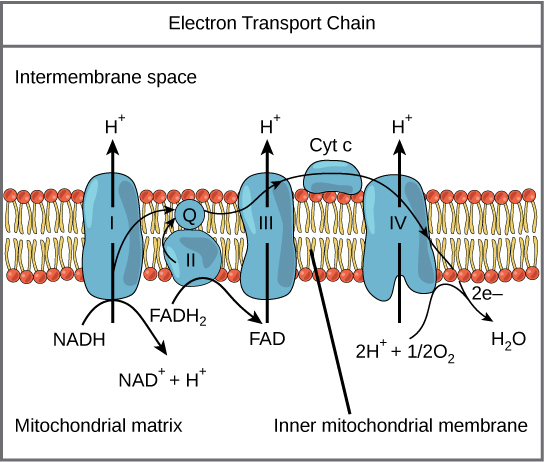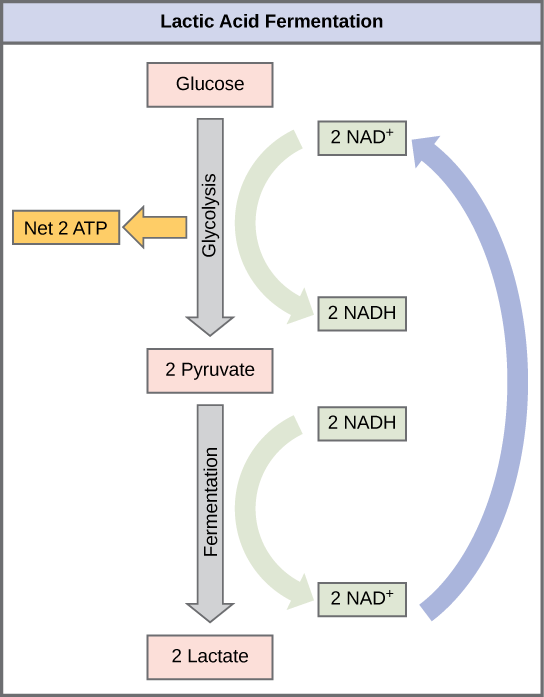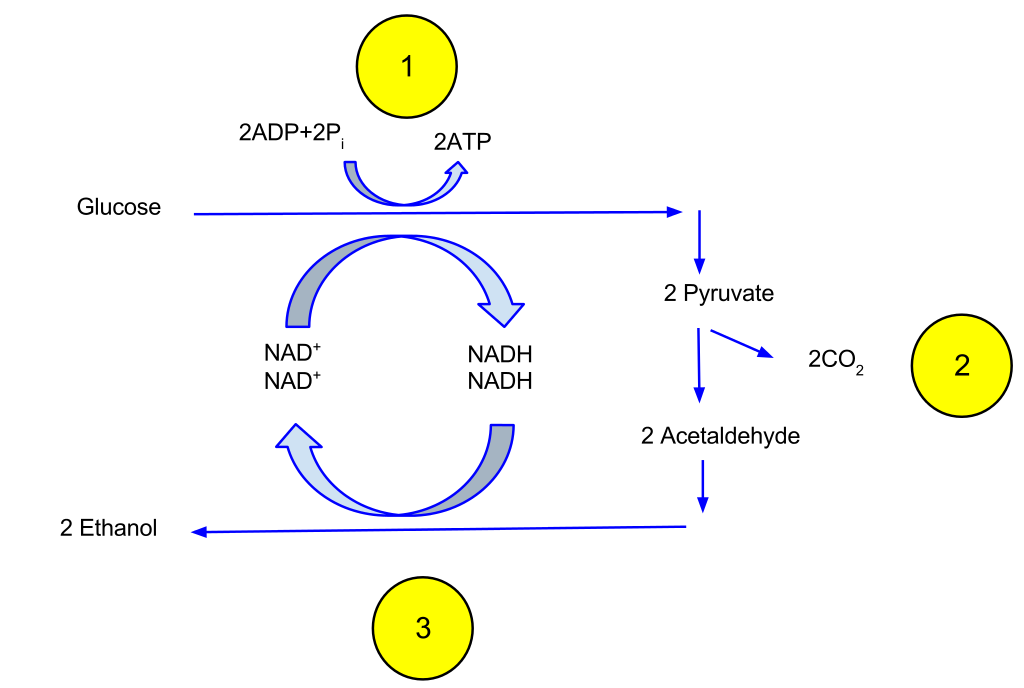Cellular Respiration Study Guide
Introduction
We have heard mitochondria referred to as the powerhouse of the cell and ATP as the fuel. But how does our body create and maintain a steady supply of these energy rich molecules to power us through our day? This guide helps decipher cellular respiration: the process by which ATP molecules are created!
What is cellular respiration?
Cellular respiration occurs in all living things and helps convert glucose into energy by extracting the energy from the bonds in glucose. This energy is generated as ATP, which the cell can then use to perform its many functions.
Cellular respiration is of two types: aerobic (if oxygen is present) and anaerobic (in the absence of oxygen). All cells in humans, other animals, and plants almost exclusively use aerobic respiration to produce more energy and power the cell’s activities.
In eukaryotic cells, cellular respiration will occur in the cytoplasm and mitochondria, and in prokaryotic cells, it will occur in the cytoplasm.
🌍 Cellular respiration has three primary stages: glycolysis, the Krebs cycle, and electron transport chain.
Glycolysis
- It is the first pathway employed in the breakdown of glucose to extract energy in the form of ATP and occurs in the cytosol of our cells.
- The process starts with glucose and ends with two pyruvate molecules, four ATP molecules, and two molecules of NADH. ATP and NADH are used as energy sources by our bodies.
- Glycolysis involves two parts: The first part separates the six-carbon ring of glucose into two three-carbon sugars called PGAL. ATP is utilized in this process to energize the separation.
- The second half of glycolysis involves the rearrangement of PGAL to pyruvate, generating ATP and attaching H+ ions to NAD+.
🌍 Glycolysis thus extracts from a glucose molecule, four ATPs, and two NADHs.
- As two ATP molecules are utilized initially, the total net energy is two ATPs and two NADHs available to the cell. The pyruvate formed is taken to the mitochondrial matrix, and in a reaction called pyruvate oxidation is converted into acetyl CoA with the release of CO2 and a molecule of NADH.
🌍 Mitochondria, the most productive centres of cellular respiration emerged from bacterial ancestors during endosymbiosis.
Kreb’s Cycle
The citric acid cycle is a succession of redox and decarboxylation reactions wherein citrate is oxidized to produce CO2 and release high-energy electrons. It takes place in the mitochondrial matrix. The outcome of this cycle is that these electrons form NADH and FADH2. These energy carrier molecules carry the energy to the electron transport chain, which is the next step. The Krebs Cycle produces 6 NADH, 2 FADH2, 2 ATP, 4CO2 molecules and runs continuously.
The Electron Transport Chain
The electron transport chain creates the most significant number of ATP molecules. It utilizes the flow of electrons through a series of integral membrane proteins on the inner mitochondrial membrane. To begin with, the hydrogen atoms and electrons that the electron carriers formed in the Krebs cycle carry are separated. These electrons then move through a series of proton pumps where these proteins use the energy from the moving electrons to pump hydrogen ions into the intermembrane space.
The pumping of hydrogen ions forms a high concentration gradient in the intermembrane space. ATP synthase uses this chemiosmotic gradient to add phosphate groups to ADP molecules to create ATP by phosphorylation. This process is called chemiosmosis, as ATP synthase allows a proton to move from a high to a low concentration. The energy released is used to create ATP. The entire process is called oxidative phosphorylation because oxygen is the final electron acceptor at the end of the chain and forms H2O.
Fermentation
Processes that use an organic molecule to regenerate NAD+ from NADH are collectively referred to as fermentation. This is observed in cellular respiration that occurs in the absence of oxygen. Here also, NADH must be reoxidized to NAD+ even without the final electron acceptor oxygen molecule. This is made possible by the process of fermentation.
There are two common ways that fermentation occurs:
Lactic Acid Fermentation
This fermentation is observed in animals and certain bacteria. It occurs in our RBCs and skeletal muscles that have an insufficient oxygen supply due to strenuous exercises. From the reaction, we notice the NADH is recycled to NAD+, allowing glycolysis to keep occurring.
🌍 Pyruvic acid + NADH ↔️ lactic acid + NAD+ Alcoholic Fermentation
Alcoholic fermentation is seen in yeast strains where pyruvate in glycolysis is transformed to carbon dioxide and ethanol. The NADH is recycled to NAD+ to ensure an adequate supply of NAD+, and hence ATP can be continuously produced.
🌍 All forms of fermentation, except lactic acid fermentation, produce gas.
Conclusion
- Cellular respiration occurs in all living things and helps convert glucose into energy by extracting the energy from the bonds in glucose.
- Glycolysis is the first pathway employed in the breakdown of glucose to extract energy in the form of ATP and occurs in the cytosol of our cells.
- The electron transport chain creates the most significant number of ATP molecules.
- The citric acid cycle is a succession of redox and decarboxylation reactions wherein citrate is oxidized to produce CO2 and release high-energy electrons.
- Processes that use an organic molecule to regenerate NAD+ from NADH are collectively referred to as fermentation.
FAQs:
1. Where does cellular respiration take place?
Cellular respiration takes place in the cytoplasm and the mitochondria. Aerobic respiration (with oxygen) takes place in the cell’s mitochondria, and anaerobic respiration (without oxygen) takes place within the cell’s cytoplasm.
2. What is the equation of cellular respiration?
3. What role does cellular respiration play in the carbon cycle?
Both cellular respiration and photosynthesis are important parts of the carbon cycle. The pathway through which carbon is recycled in the biosphere is called the carbon cycle while cellular respiration releases carbon dioxide into the environment, photosynthesis pulls carbon dioxide out of the atmosphere.
4. What is the role of oxygen in cellular respiration?
Oxygen is an electron acceptor and it accepts the final electrons during the electron transport chain. This helps in the production of adenosine triphosphate (ATP).
5. What role does cellular respiration play in the water cycle?
In the first step of cellular respiration (glycolysis), energy is extracted from glucose, thus removing it from the atmosphere. During the final step of cellular respiratio (electron transport chain), water is released back into the cell, from where it could return into the atmospher.
We hope you enjoyed studying this lesson and learned something cool about Cellular Respiration! Join our Discord community to get any questions you may have answered and to engage with other students just like you! We promise, it makes studying much more fun 😎
Sources:
-
“Glycolysis – Biology for AP® Courses – OpenStax.” Openstax.org, 2018, openstax.org/books/biology-ap-courses/pages/7-2-glycolysis. Accessed 06 Dec. 2021.
-
Osellame, Laura D., et al. “Cellular and Molecular Mechanisms of Mitochondrial Function.” Best Practice & Research. Clinical Endocrinology & Metabolism, vol. 26, no. 6, 1 Dec. 2012, pp. 711–723, www.ncbi.nlm.nih.gov/pmc/articles/PMC3513836/, 10.1016/j.beem.2012.05.003. Accessed 6 Dec. 2021.

